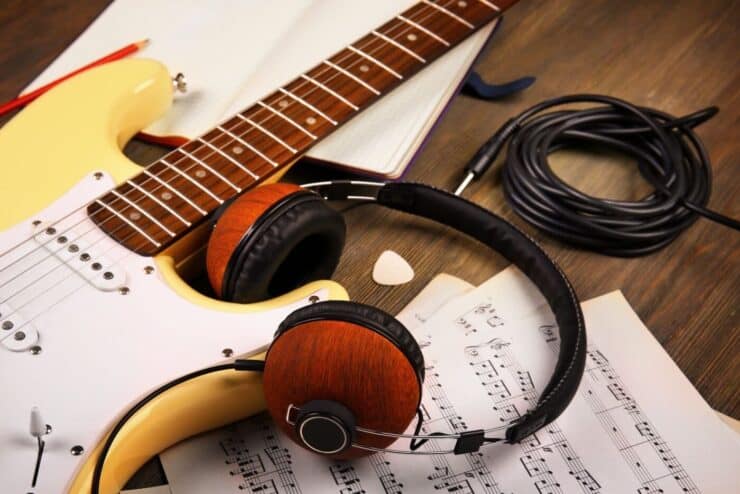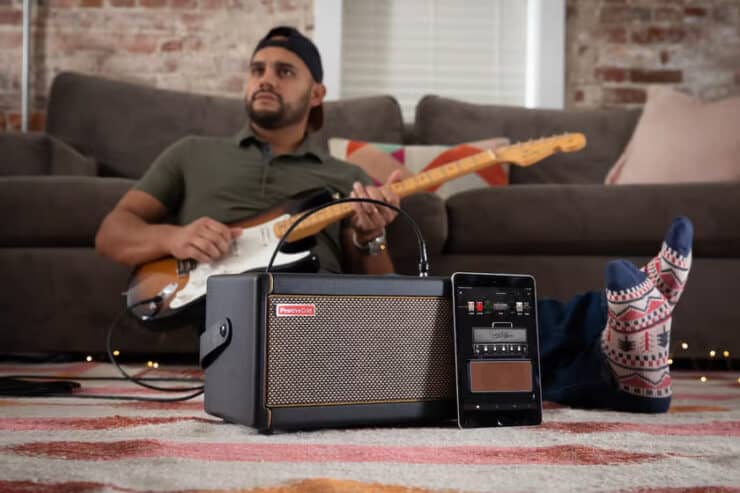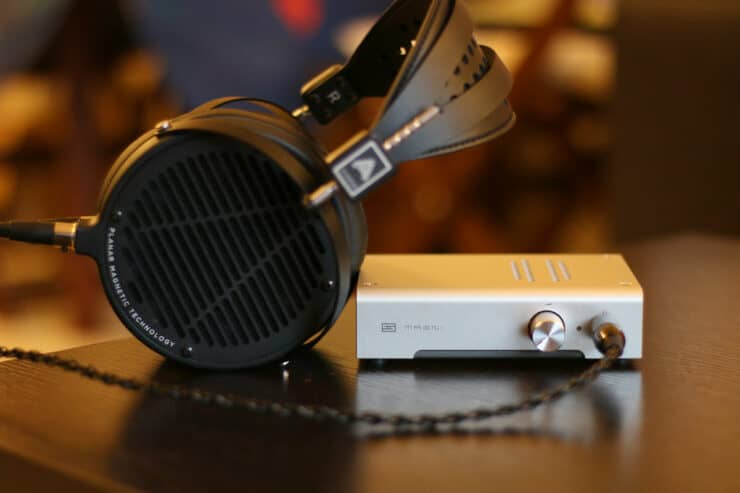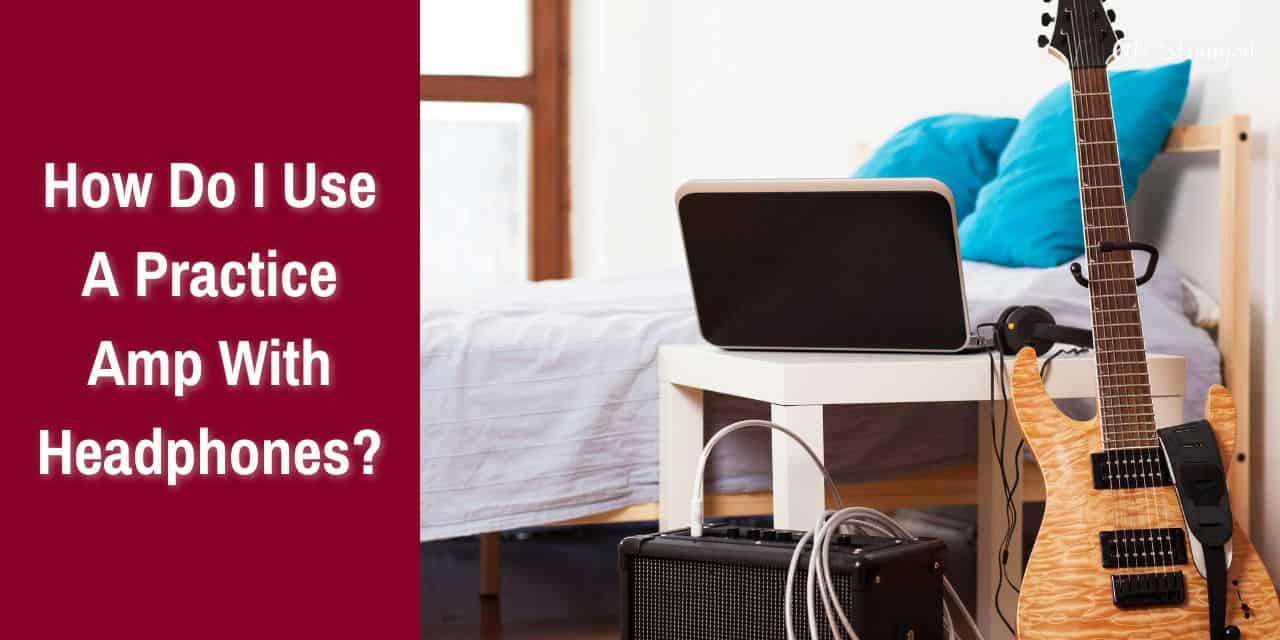For guitar players who are looking to practice without disturbing others, learning how to use a practice amp with headphones is a great way to achieve your goals. With the right equipment and setup, you can get the same quality of sound from your headphones as you would from a speaker. In this article, you’ll learn the basics of how to use a practice amp with headphones and start playing the guitar in peace. Don’t miss out on this opportunity to take your practice sessions to the next level!
Overview of using practice amps with headphones
A practice guitar amp is an electronic device that takes weak electronic signals from a guitar and turns them into much louder signals. This is done by using a series of electronic components that then amplify the signal. A practice amp can be used for making a guitar sound louder through a speaker, or it can be used for making the guitar sound louder when played through headphones.
Yes, it is possible to plug headphones into a practice amp. This will be useful if you wish to practice without disturbing others, or if you want to hear your guitar’s sound more clearly. Headphones can help you get a better sound from your amp. There are multiple ways you can get guitar amp action using headphones.
The first way would be to use a guitar amp simulator. There are different simulator pedals on the market and they work in different ways. Some users make use of digital signal processing for simulating the sound of a tube amp, whereas others use analog circuitry.
The second way would be to utilize a DI box. A DI Box is an electronic device that takes signals from the guitar and converts it to balanced signals that are then sent to a mixer or audio interface. This is the best way to get a clean sound when recording, it can even be used to get a dirty sound if needed.
ALSO READ: Best Practice Amp: Top 7 Picks to Play Anywhere!
The third way will be to use an amp-modeling pedal. These pedals take the signal from the guitar and run it through various algorithms that model the sound of different amps. This can give you a realistic guitar sound when played through headphones. Regardless of the method you’re choosing, you can certainly use a practice amp with headphones by using one of these methods.
Even though headphones are a wonderful option for playing electric guitar, you must also consider the type of amps and connections it offers before hooking them up. Solid-state amps, preamps, and multi-effect units come with headphone outputs. You can run the signal into a UBS audio interface if the amp doesn’t have one. However, if you don’t have one, there are many other options. Most solid-state amps come with headphones as input. This feature is available only for solid-state amplifier preamps.

How do I use a practice amp with headphones?
Using a practice amp with headphones is a great way to practice playing your guitar without disturbing others. However, connecting your headphones to the practice amp and using it can be somewhat tricky, especially if you haven’t done it before. Here are the step-by-step instructions on how to connect a practice amp to headphones and use it to get the best possible sound –
#1. Choose the right headphones
The first step for using a practice amp with headphones will be to choose the right headphones. There are different types of headphones available in the market and they have their unique sound characteristics. Closed-back headphones offer a more isolated sound, whereas open-back headphones offer a more natural sound. Choose the headphones that work best for you and your style of music.
#2. Locate the headphone jack
The next step would be to locate the headphone jack on your practice amp. It is generally located on the front or back of the amp and marked with a headphone icon. If you cannot find it, you should consult your practice amp’s manual.
#3. Connect the headphones
Once you have found the headphone jack, you should connect your headphones to it. You should ensure that the plug is firmly inserted into the jack. If your headphones come with a volume control, you should set it to the minimum level.
#4. Adjust the settings
Now comes the time to adjust the settings on your practice amp. Start off by turning down the master volume to avoid potential damage to your ears or headphones. After that, adjust the gain or volume controls to get the desired level of distortion or overdrive. If your amp has built-in effects like delay or reverb, you should experiment with them to find the sound that you like.
#5. Play and listen carefully to get the best sound
Once you have adjusted the settings, you should start playing your guitar and listen to the sound carefully through your headphones. If the sound is too quiet, you should turn up the gain or volume controls. Meanwhile, if the sound is too loud, you should adjust the master volume or your headphone volume control. Experiment with different settings until you get the sound that works best for you.
Different ways to play electric guitar silently with headphones
If you are looking to create the perfect, in-the-moment sound, it is possible to play with your electric guitar silently via a pair of headphones. The different ways to play electric guitar silently include an acoustic amp, a headphone amp, or a guitar effects pedal.
When you’re deciding on the type of silent guitar to use, it’ll be a smart idea to think of what you are looking for. If you are looking to perform in a live setting, like a recording studio, you prefer using a headphone amplifier. Meanwhile, if you’re going to practice at home, you might want to use a headphone amp or a guitar effects pedal that has a headphone output. If you are looking to play the guitar silently, there are several benefits that come with it.
Benefits of using a practice amp with headphones
Playing the guitar is a wonderful way of expressing your creativity and musical talent. However, it can be a slightly noisy and disruptive activity for people around you. Fortunately, using a practice amp with headphones can help you practice quietly without disturbing other people. There are many other benefits of using a practice amp with headphones too. Here are some of them –
#1. Practice anywhere at any time
One of the main benefits of using a practice amp with headphones will be the ability to practice anywhere, at any time. Whether you have roommates, live with family, live in an apartment, or simply don’t want to disturb your family or neighbors, a practice amp with headphones will allow you to play your guitar without worrying about noise levels.
#2. Privacy
Another benefit of using a practice amp with headphones will be the privacy factor. When you’re practicing with headphones, you can concentrate on your playing without distractions from external noise. This will allow you to focus on your timing, technique, and musicality, improving your skills and confidence along the way.
#3. Better sound quality
When you’re using headphones with a practice amp, you’ll get better sound quality than when you’re playing through the amp’s built-in speaker. Headphones can easily pick up the subtle nuances of your playing, making it much easier to identify areas for improvement. Moreover, you can also use different types of headphones to customize the sound, such as closed-back or open-back headphones, depending on your personal preference.
#4. Experiment with different effects
Many practice amps come with built-in effects like chorus, reverb, and delay. When you’re using headphones with a practice amp, you can easily experiment with these effects without disturbing others around you. This will allow you to discover new sounds and styles, improving your creativity and musicality.
#5. The affordability factor
Practice amps with headphone jacks are often more affordable compared to larger amps with built-in speakers. This makes them a great option for beginner guitarists or people on a tight budget. Moreover, they are often more portable and easier to transport compared to larger amps, which makes them ideal for traveling, rehearsals, and gigs.

Different types of practice amps
There are different types of practice amps that allow you to practice quietly without disturbing other people. Many of them come with a headphone jack, allowing you to easily practice without any noise. Here are some of the different types of practice amps that are ideal for use with headphones.
#1. Solid-state amps
Solid-state amps are popular among guitarists due to their affordable price, reliability, and durability. They’re ideal for practice sessions, especially when they’re used with headphones. These amps make use of transistors for amplifying the guitar signal, making them much more reliable and durable than tube amps. Solid-state amps are relatively lightweight, which makes them easy to transport to gigs and rehearsals.
#2. Digital-modeling amps
Digital-modeling amps are designed for simulating the sounds of different types of amps, speakers, and effects. They are popular among guitarists who love experimenting with different sounds and styles. These amps are extremely versatile and can produce a wide range of tones, which makes them ideal for practice sessions. These amps come with built-in effects such as delay, reverb, and chorus, allowing you to create the desired sound and tone.
#3. Tube amps
Tube amps are another popular option among guitarists for their warm and organic sound. They make use of vacuum tubes for amplifying the guitar signal, which makes them ideal for rock, blues, and metal genres. Tube amps are slightly more expensive compared to solid-state and modeling amps but they’re well worth the investment for guitarists who want a rich and authentic sound.
#4. Hybrid amps
Hybrid amps combine the best of solid-state and tube amps. They use both vacuum tubes and solid-state components to amplify the guitar signal, resulting in a warm and organic sound. Hybrid amps are more affordable than tube amps but offer a similar sound quality. These amps are ideal for practice sessions, especially when used with headphones.
#5. Mini amps
Mini amps are small, portable, and battery-powered amps that are perfect for practice sessions on the go. They are extremely lightweight and compact, which makes them easy to carry around. Mini amps come with a headphone jack, making them perfect for use with headphones. They are easily affordable and offer a wide range of sounds, which makes them a popular choice among guitarists who want a portable and versatile practice amp.

Tips to keep in mind when using a practice amp with headphones
A practice amp is an invaluable tool for guitarists who want to hone their skills without disturbing others. Most practice amps come with a headphone jack that allows you to practice playing your guitar silently. This makes them ideal for playing in apartments or late at night when others around you are sleeping. By keeping a few tips in mind, you’ll be able to maximize on using a practice amp with headphones and getting the best experience.
#1. Adjusting the volume
When you’re using a practice amp with headphones, it’ll be important to adjust the volume properly for protecting your hearing and getting the most out of the amp. Many practice amps come with volume control, allowing you to adjust the level of sound going to the headphones. It is important that you start with the volume low and gradually increase it until you’ve reached a comfortable level.
If you aren’t sure about the proper volume level, you can use a sound level meter for measuring the decibel level. It is recommended that you keep the volume level below 85 decibels. Prolonged exposure to higher levels could damage your hearing. You can consider using headphones with noise-cancelation or sound-isolation technology for reducing the overall volume level.
#2. Using the practice amp for specific sounds
Practice amps generally come with built-in effects such as reverb, distortion, and chorus. All these effects and more allow you to experiment with different sounds and styles to get more out of your playing. When you’re using a practice amp with headphones, it’ll be essential that you take advantage of these features to create the desired sound and tone.
You can also experiment with different sounds, effects, and settings on the practice amp to find the ideal sound that best fits your playing sound and the type of music you are playing. It is also recommended that you try out different headphones to see how they affect the tone and sound of the amp.
#3. Use the EQ settings to fine-tune the sound
Another useful tip will be to use the amp’s EQ stings to adjust the bass, treble, and midrange levels to fine-tune the sound. This can greatly help you create a sound that is unique to your playing style and personal preferences.
You should try to experiment with different EQ settings to find out the perfect sound that works best for you. Moreover, keep in mind that different types of music might require different EQ settings, such that it is essential to adjust the EQ according to the type of music you are playing.
#4. Use backing tracks
Using a backing track will be a wonderful way to practice guitar with headphones. Backing tracks will offer a rhythmic accompaniment to your playing, making it much easier to practice different styles and techniques. You can find a wide range of backing tracks online or create your own tracks using a digital audio workstation (DAW) software. Experiment with different backing tracks and find out the one that works best for you, your playing style, and your preferences.
Can you use regular headphones with a practice amp?
Guitar amps typically come with a headphone jack that you can use for connecting your headphones. If your amp doesn’t have a headphone jack, you can make use of a ¼ inch or 3.5 mm adapter for connecting your headphones to the amp’s speaker output. But are there special headphones to use with practice amp, or will regular amps do just fine?
There is no straightforward answer to this question, as it will depend on the specific guitar amp you’re using. Some practice amps also come with an auxiliary input that you can use for plugging in regular headphones, whereas others might require an adapter to do so. Ultimately, it’ll be best to consult your amp’s owner’s manual to see which headphones are recommended.
Playing the guitar with headphones connected is a recreational activity for a wide variety of reasons. Traditional electric guitars don’t include a headphone jack. Despite the fact that you cannot directly use headphones with an electric guitar, they still happen to be a great option. It is necessary that you use an external amp to listen to your headphones and play guitar. The headphone amp is a small device that amplifies any signal to produce the ideal sound. Since it is small, light, and inexpensive, headphone amps are quite popular. There are many headphones that are specifically designed for silent practice.
Many guitarists prefer using Boss Waza-Air Wireless Guitar Headphones or Vox VHG AC30 Guitar Headphones for silent guitar sessions. A headphone-out or line-out is generally found on the back panel of most multi-effects pedals. A guitar headphone amp is the same thing as a bijou, except there are headphones instead of horns. It can be plugged into the guitar directly and used.
Aside from providing a fantastic décor option, practice amps are portable, inexpensive, and versatile. While some traditional electric guitars don’t always feature a headphone output jack, there are multiple MIDI options that do. There are multiple options for the best electric guitar headphones. Many professional audio engineers use Audio-Technica, Sennheiser, and AKG’s products for practicing with headphones.
A headphone-out is included with most guitar preamps, solid-state amps, and amp heads to connect a set of headphones. To avoid damaging the equipment, you should make sure that headphones aren’t connected to a speaker jack, input jack, or effects loop. If there is a gap between what you are playing and what you hear, it is referred to as latency.
When you are connecting a headphone amp to a loudspeaker, a power amp must be used for reducing its output. You can connect a headphone output to the line-level input of a preamp or receiver in addition to the headphone output. You’ll also be able to play the amp’s sound back through the loudspeaker without using the headphone jack by doing so.
FAQs
What is the benefit of using headphones with a practice amp?
Using headphones with a practice amp has several benefits, including allowing you to practice silently, offering better control over your sound, and providing a more intimate playing experience. Headphones also allow you to hear the nuances of your playing more clearly, which can help you improve your technique.
How do I connect headphones to a practice amp?
Most practice amps come with a headphone jack that can be used to connect headphones. Simply plug your headphones into the jack and turn up the volume on your amp until you can hear your playing through the headphones.
What should I consider when choosing headphones for my practice amp?
A: When choosing headphones for your practice amp, it’s important to consider the type of sound you are looking for. Closed-back headphones are great for isolating sound and blocking out external noise, while open-back headphones provide a more natural sound. Additionally, you should consider the comfort of the headphones and the sound quality.



